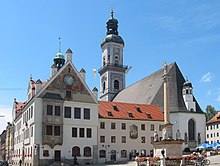St. Georg (Freising)

The parish church of St. Georg is the central parish church in Freising .
location
The church is located in the middle of Freising's old town , north of Domberg , near Marienplatz . The Ziererhaus , the town hall and the Asam building are in the immediate vicinity .
history
First mentioned in a document in 1230, from 1250 pastoral care for the city of Freising was transferred from Domberg to Moosach Valley to a predecessor of today's Georgskirche. "St. Jörg im Moos ”was probably built in the 10th century and the church was obviously rebuilt around 1200. The east facade connects to the "Marienplatz" market square, and together with the town hall that was built next to it, it formed the urban center of the town.
Today's church was a new building from 1440, built in the late Gothic style and completed in 1494. It is a three-aisled relay hall; the vaults of the two aisles are slightly lower than the central nave. The net vault contains beautifully painted keystones. The two portals are in the south and north in the rear part of the church. The crucifix on the choir arch - a larger-than-life corpus - was created around 1450. On the west wall (south side aisle) an early Baroque monumental large-scale sculpture “The Dragon Fight of St. George” from 1660. On the west wall (north aisle) three late Gothic wooden altar panels “Last Judgment”.
The 84 meter high baroque tower in the west of the church - with the lantern dome, which can be climbed to the balustrade every Saturday afternoon from May to October - was built by Antonio Riva from 1679 to 1689 . The previous tower buildings were demolished due to dilapidation, which is also related to the subsoil. The tower has a four-storey substructure followed by the bell storey.
The cemetery was originally near the church, but was then rebuilt in 1543 - together with the Gottesackerkirche St. Maria - outside the city wall (north of the brick gate).
After the secularization in 1803, the pastoral duties of the dissolved collegiate parishes of St. Andreas and St. Veit were finally transferred to St. Georg in 1837. In the 19th century the parish church was furnished in a neo-Gothic style. By 2003 the church was restored in the version from 1497. The modern lamellar altar , on which a picture of the no longer existing Gothic high altar is etched, comes from the artist couple Lutzenberger from Bad Wörishofen .
Organs
Main organ
The organ was built in 1938 by Willibald Siemann . The cone chopping instrument has 43 stops (including three transmissions ) on three manuals and pedal and is arranged in the late romantic style . The actions are electro-pneumatic .
|
|
|
|
|||||||||||||||||||||||||||||||||||||||||||||||||||||||||||||||||||||||||||||||||||||||||||||||||||||||||||||||||||||||||||||||||||||||||||||||||||
- Pair : II / I, III /, III / II, Super III / I, Super III / II, I / P, II / P, III / P
- Playing aids : Swell kick for the swell, crescendo kick, 2 free combinations, free piano pedal
- Remarks
Choir organ
A choir organ was built by the Sandtner company in 1970 to represent older organ music and for smaller forms of worship . The instrument was subsequently rescheduled slightly. The slider chest instrument has 13 stops on two manuals and a pedal. The playing and stop actions are mechanical.
|
|
|
|||||||||||||||||||||||||||||||||||||||||||||||||||||
- Coupling : II / I, I / P, II / P
Bells
The parish church has a four-part bell (C major) and a small death bell . This sounds after the evening angelus bell in memory of the deceased. On Saturdays at 3 p.m., all bells ring in Sunday for 12 minutes.
|
No. |
Surname |
Casting year |
Foundry, casting location |
Weight (kg) |
Nominal |
| 1 | Holy Cross Bell | 1691 | Johann Gordian Schelchshorn , Regensburg | 2300 | c 1 |
| 2 | Antonius Bell | 1950 | Karl Czudnochowsky , Erding | 1400 | d 1 |
| 3 | Christ the King bell | 1950 | Karl Czudnochowsky, Erding | 1000 | e 1 |
| 4th | 1950 | Karl Czudnochowsky, Erding | g 1 | ||
| 5 | Train / death bell | 1694 | 105 | a 2 |
literature
- Walter Brugger and Rudolf Goerge: The churches of the parish St. Georg, Freising. Schnell & Steiner 1972. State Library, Regensburg. Sig 999 / Item 639 (978).
Individual evidence
- ↑ Data acquisition by user Violon 16´ 2013/2015/2018
- ↑ To the organ on the website of the organ building company Eder
- ↑ The choir organ on the manufacturer's website , accessed on June 29, 2017
- ↑ Information on the organ at organindex.de
Web links
Coordinates: 48 ° 24 ′ 3 " N , 11 ° 44 ′ 35" E





